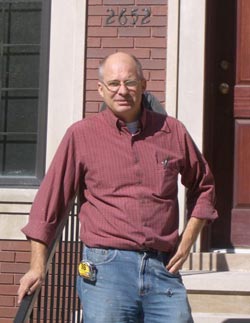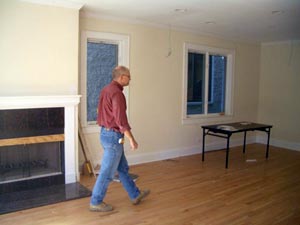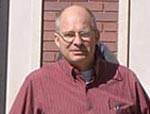 Last week, a local builder, Paul Ahlrich of Grun Development, sat down with me for a frank talk about his experience building and selling new houses in Chicago. Ahlrich got into the business slowly at first, and then in early 2006, took a headlong plunge, building three new upscale houses in Humboldt Park—houses he expected to sell before or shortly after their completion.
Last week, a local builder, Paul Ahlrich of Grun Development, sat down with me for a frank talk about his experience building and selling new houses in Chicago. Ahlrich got into the business slowly at first, and then in early 2006, took a headlong plunge, building three new upscale houses in Humboldt Park—houses he expected to sell before or shortly after their completion.
The three houses, built with supertight insulation and other green features, were completed in mid-2007. One sold that summer, the second sold last week—with all the proceeds going to Ahlrich’s lender—and the third still stands empty. Here, in an edited transcript, Ahlrich describes how he got to this point.
I was in a corporate job until I was downsized in 2001. I already owned a couple or three buildings [as an investment] on the West Side, in a tough area. I started buying and renovating two-flats there. There was a little bit of a margin to picking them up and renovating them. Then I had a couple of vintage buildings in Ukrainian Village and I did gut rehabs on them. Then I built my first house, in Ukrainian Village, and sold it for about $550,000.
Three years ago I was doing a renovation on a building [on the 2600 block of West Walton Street] when a guy came up to me and said his family had owned the three-flat across the street and three empty lots [next to it] since 1894. Was I interested in buying them? I bought it all for $1.3 million. I started with the three-flat—she was leaning so bad, we had to build a steel apron around it and lift it up with hydraulics. Now that thing is as plumb as can be. It’s really something; it has original woodwork from 1894, seven-foot mirrors surrounded in quarter-sawn white oak, and cabinets and doors and chair rails in that same oak. I sold the three units there as condos.
I kept putting every dime back into the company, and my bank, the Brickyard Bank in Lincolnwood, stayed with me and guided me and helped me. We put everything into the business. In 2006 we had between $2.25 million and $2.5 million in sales. That was for three or four places in Ukrainian Village.
In May of 2006, I started on these three [Humboldt Park] houses. In hindsight I can tell you, I could have done them one at a time. But everybody’s always wanted my stuff. I could see there was a lot [of building] going on. I’d differentiate myself; I’d build a better mousetrap. I learned how to build green. I’d build them so tight that the energy bills would be so low you’d want these houses.
I expected to make my living on the third house. [As a builder-investor] you first put your equity down, and then your loans. The first sale would get my equity back, the second and third would pay the bank, and part of the third house was [going to be] my profit. I thought they would all be sold by the end of 2007. It wasn’t going to be a huge profit margin; I was building these to make my reputation for [building green].
I had several other projects going, too. I was going to do a green renovation [of a popular North Side pub], and I was going to build a green marketplace in Humboldt Park. I had some green home renovations [for residential clients]. Now, these three houses have been done for a year and a half. They were priced at $939,000 [for the corner house], $919,000, and $899,000. [The house on the corner sold in July 2007 for $923,000; the middle house sold 15 months later, for $898,000.]
They’ve just sat here. I’ve told myself that Western [Avenue] is a barrier; people don’t want to come over here [three blocks west of Western]. People have told me it’s not me, it’s timing, everything is unsold. That last house is costing me probably five grand to carry each month. You have fixed costs, taxes and utilities; you can’t let a house go cold in the winter. The clock is running on that one.
But my bank brought me to this game. I’m not going to leave them now. People have told me I could walk away from [the third house], give it to the bank. But I won’t do that. They’ll get the [proceeds.] I gave them my word. In essence, I’m working for free now. That’s not what I signed up for. And everything else has stopped.
I’m not alone. Everyone’s dead in the water. The homebuilders association said six weeks ago that transactions are down 29 percent, and of the transactions, 39 percent are foreclosures or short sales.
My wife works, and I have my resumé updated. But right now I have work. Somebody bought a couple of foreclosure homes at 45 cents on the dollar in Logan Square, and we’re doing energy-efficient gut rehabs. There’s an investor who might be interested in having me build [energy-efficient] low-income housing. There are other things. Everybody’s interested, but this economy is in a contraction. At the rate things are canceling, I don’t know.
I’m stressed, but I’m scared for my men. I was at 12 or 13 guys a year ago; now I’m down to five guys. So I’ve cut my weekly payroll by $5,200 a week. I just don’t have any work for them.
 I was buying [some construction materials] from two guys who were just becoming American citizens. They were putting everything they made back into the business, and now they have nothing. What do you tell them? They came over here for the American Dream. How do they get clear of the hole they’re in now? Builders are going to be obsolete in Chicago for two years, at least.
I was buying [some construction materials] from two guys who were just becoming American citizens. They were putting everything they made back into the business, and now they have nothing. What do you tell them? They came over here for the American Dream. How do they get clear of the hole they’re in now? Builders are going to be obsolete in Chicago for two years, at least.
I knew this was a tough game I was getting into—I’d been in construction, one way or another, for 25 years, since college—but I thought I was clever and competent. I was building what I think is the best product in the city.
On the news I keep hearing that people like me were irresponsible, that we went too far. I never thought I was being irresponsible. I had sold everything I built; I was always pushing, developing a better product. And the bankers were saying, “Let’s go. This is a good idea, the green building.”
Now, in hindsight, I cringe. I was irresponsible. Who did I think I was? I exposed myself to the tidal wave [of debt] that is engulfing the world right now. I don’t feel competent now. I’m being spanked pretty hard.
But I’m proud of what I built here. I’m proud that I can do this. It’s something creative that I’m good at.
 Last week, a local builder, Paul Ahlrich of Grun Development, sat down with me for a frank talk about his experience building and selling new houses in Chicago. Ahlrich got into the business slowly at first, and then in early 2006, took a headlong plunge, building three new upscale houses in Humboldt Park—houses he expected to sell before or shortly after..." />
Last week, a local builder, Paul Ahlrich of Grun Development, sat down with me for a frank talk about his experience building and selling new houses in Chicago. Ahlrich got into the business slowly at first, and then in early 2006, took a headlong plunge, building three new upscale houses in Humboldt Park—houses he expected to sell before or shortly after..." />



